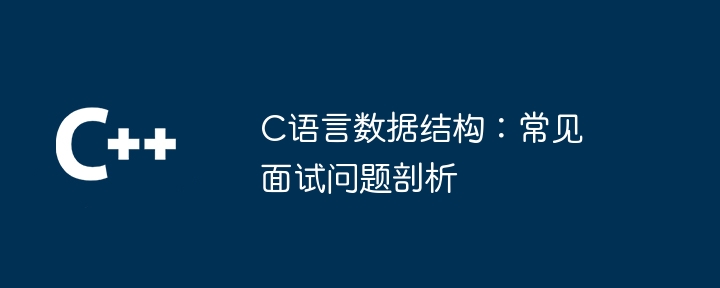数据结构是 c 语言面试中的关键知识点:指针和数组:理解指针指向数组起始地址并用于访问和修改数组元素。链表:实现单向链表,掌握创建、插入和删除操作。栈:利用数组构建栈,理解压栈、出栈和查看栈顶操作。队列:使用数组实现队列,掌握入队、出队和查看队首操作。

在许多编程面试中,数据结构都是不可避免的话题。掌握 C 语言中的常见数据结构及其应用对于求职者来说至关重要。
1. 指针和数组
理解指针指向数组起始地址的原理。
立即学习“C语言免费学习笔记(深入)”;
int arr[] = {1, 2, 3, 4, 5};
int *ptr = arr; // 指向数组首元素使用指针访问和修改数组元素。
printf("%d\n", *ptr); // 输出 1
*ptr++; // 指向下一个数组元素
printf("%d\n", *ptr); // 输出 22. 链表
实现单向链表及其基本操作(创建、插入、删除)。
struct node {
int data;
struct node *next;
};
struct node *head = NULL; // 链表头部
// 创建链表
void create_list(int data) {
struct node *new_node = malloc(sizeof(struct node));
new_node->data = data;
new_node->next = NULL;
if (head == NULL) {
head = new_node;
} else {
struct node *current = head;
while (current->next != NULL) {
current = current->next;
}
current->next = new_node;
}
}
// 插入节点到链表特定位置
void insert_node(int data, int position) {
struct node *new_node = malloc(sizeof(struct node));
new_node->data = data;
if (position == 0) {
new_node->next = head;
head = new_node;
} else {
struct node *current = head;
for (int i = 0; i < position - 1 && current != NULL; i++) {
current = current->next;
}
if (current != NULL) {
new_node->next = current->next;
current->next = new_node;
}
}
}
// 删除链表特定位置的节点
void delete_node(int position) {
struct node *current = head;
if (position == 0) {
head = head->next;
} else {
for (int i = 0; i < position - 1 && current != NULL; i++) {
current = current->next;
}
if (current != NULL && current->next != NULL) {
struct node *temp = current->next;
current->next = temp->next;
free(temp);
}
}
}3. 栈
实现栈并使用数组模拟,理解栈的基本操作(压栈、出栈、查看栈顶)。
#define MAX_SIZE 100
int stack[MAX_SIZE];
int top = -1; // 栈顶指针
// 压栈
void push(int data) {
if (top == MAX_SIZE - 1) {
printf("Stack overflow\n");
} else {
stack[++top] = data;
}
}
// 出栈
int pop() {
if (top == -1) {
printf("Stack underflow\n");
return -1;
} else {
return stack[top--];
}
}
// 查看栈顶元素
int peek() {
if (top == -1) {
printf("Empty stack\n");
return -1;
} else {
return stack[top];
}
}4. 队列
使用数组实现队列,理解队列的基本操作(入队、出队、查看队首)。
#define MAX_SIZE 100
int queue[MAX_SIZE];
int front = -1, rear = -1;
// 入队
void enqueue(int data) {
if ((front == 0 && rear == MAX_SIZE - 1) || (rear + 1 == front)) {
printf("Queue overflow\n");
} else if (front == -1) {
front = rear = 0;
queue[rear] = data;
} else if (rear == MAX_SIZE - 1) {
rear = 0;
queue[rear] = data;
} else {
rear++;
queue[rear] = data;
}
}
// 出队
int dequeue() {
if (front == -1) {
printf("Queue underflow\n");
return -1;
} else if (front == rear) {
int data = queue[front];
front = rear = -1;
return data;
} else {
int data = queue[front];
front++;
return data;
}
}
// 查看队首元素
int peek() {
if (front == -1) {
printf("Queue empty\n");
return -1;
} else {
return queue[front];
}
}以上就是C语言数据结构:常见面试问题剖析的详细内容,更多请关注php中文网其它相关文章!

每个人都需要一台速度更快、更稳定的 PC。随着时间的推移,垃圾文件、旧注册表数据和不必要的后台进程会占用资源并降低性能。幸运的是,许多工具可以让 Windows 保持平稳运行。




Copyright 2014-2025 https://www.php.cn/ All Rights Reserved | php.cn | 湘ICP备2023035733号